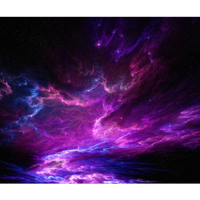The cosmos, with its vast expanse, holds many secrets, and among its enigmatic phenomena is the concept of “reflected light.” As light journeys through the universe, it often encounters celestial bodies, interacts with their surfaces, and then embarks on a return journey to our telescopes on Earth. These cosmic echoes, traveling for thousands or even millions of years, carry invaluable information about the universe’s history and composition. In this essay, we will embark on a thrilling journey into the world of detecting ancient, reflected light and explore the remarkable technologies and techniques that enable us to decipher the mysteries concealed within these cosmic echoes.
The Cosmic Time Machine: The Journey of Reflected Light
Before we delve into the intricacies of detecting ancient, reflected light, let’s first comprehend the incredible odyssey it undergoes. The journey begins with a distant source of light, perhaps a star or a galaxy, emitting photons that traverse the universe at the speed of light—approximately 299,792,458 meters per second. These photons carry information about the object they originated from, including its composition, temperature, and distance from Earth.
However, the path of these photons is often fraught with celestial encounters. Some may bounce off planets, moons, or asteroids, while others may interact with dust clouds or pass through the atmospheres of various celestial bodies. These interactions alter the photons’ properties, imprinting them with a unique signature of their cosmic journey. After their long voyage, some of these photons eventually reach Earth, where astronomers and scientists eagerly await their arrival.
The Quest for Ancient Light: Detecting Cosmic Echoes
Detecting ancient, reflected light is a complex and awe-inspiring endeavor that combines cutting-edge technology, ingenious techniques, and a profound understanding of the universe’s workings. Here’s how astronomers and scientists unlock the secrets hidden within these cosmic echoes:
1. Powerful Telescopes: The foundation of detecting ancient, reflected light lies in the use of powerful telescopes. Modern observatories, both ground-based and space-based, are equipped with sophisticated instruments that can capture incredibly faint signals. Telescopes like the Hubble Space Telescope and the James Webb Space Telescope are specifically designed to capture and analyze light from distant celestial objects.
2. Spectroscopy: Spectroscopy is a fundamental technique used to dissect ancient, reflected light. It involves splitting the incoming light into its constituent colors, much like a prism disperses sunlight into a rainbow. By analyzing the spectrum of light, astronomers can determine the chemical composition of celestial objects, their temperature, density, and even their motion relative to Earth.
3. Adaptive Optics: Earth’s atmosphere can distort and blur incoming light, posing a significant challenge for astronomers. Adaptive optics systems are used to compensate for this distortion in real-time, allowing telescopes to capture sharper images. By correcting for atmospheric turbulence, astronomers can study ancient, reflected light with unprecedented clarity.
4. Gravitational Lensing: The concept of gravitational lensing, predicted by Albert Einstein’s theory of relativity, plays a pivotal role in detecting ancient, reflected light. Massive objects like galaxies and clusters of galaxies can bend and magnify the light from more distant objects behind them. This phenomenon acts as a cosmic magnifying glass, enabling astronomers to observe faint, distant objects that would otherwise be hidden.
5. Photometry and Photodetectors: Sensitive photodetectors and photometry techniques are employed to measure the intensity of ancient, reflected light. These detectors can register even the faintest of signals, allowing astronomers to collect data over long periods and detect extremely distant or dim celestial objects.
Cosmic Wonders Unveiled: What Ancient Reflected Light Reveals
The detection of ancient, reflected light has led to numerous groundbreaking discoveries and provided us with insights into the universe’s history and composition. Here are some of the remarkable cosmic wonders unveiled through this scientific endeavor:
1. Exoplanets: By studying the tiny variations in starlight caused by the passage of exoplanets in front of their host stars, astronomers have detected and characterized thousands of exoplanets. This has expanded our understanding of planetary systems beyond our solar system, paving the way for the search for habitable worlds.
2. Distant Galaxies: Ancient, reflected light has allowed us to observe galaxies that existed when the universe was in its infancy. These distant galaxies offer a glimpse into the universe’s past, shedding light on its evolution and expansion.
3. Stellar Life Cycles: Studying the light reflected off celestial objects like stars and nebulae has provided insights into their life cycles. Astronomers can determine the age, temperature, and chemical composition of stars, helping us understand the processes that govern their birth, life, and eventual demise.
4. Dark Matter: The gravitational lensing effect, facilitated by ancient, reflected light, has been instrumental in mapping the distribution of dark matter in the universe. This mysterious and elusive substance is thought to make up a significant portion of the cosmos and plays a crucial role in shaping its structure.
5. Cosmic Microwave Background: Ancient, reflected light also includes the cosmic microwave background radiation, a faint afterglow of the Big Bang. By studying this radiation, scientists have gained valuable insights into the early universe’s conditions and its subsequent evolution.
The Quest Continues: Future Prospects and Challenges
While we’ve made significant strides in detecting ancient, reflected light, the cosmos continues to beckon with its mysteries and challenges. Future advancements in technology and space exploration promise to expand our capabilities even further. Here are some of the exciting prospects and challenges on the horizon:
1. James Webb Space Telescope (JWST): The upcoming launch of the James Webb Space Telescope promises to revolutionize our understanding of the universe. With its advanced instruments and capabilities, the JWST will be a formidable tool for detecting ancient, reflected light from the farthest reaches of the cosmos.
2. Dark Energy and Dark Matter: Understanding the nature of dark energy and dark matter remains one of the most significant challenges in cosmology. The study of ancient, reflected light, particularly through gravitational lensing, will continue to play a vital role in unraveling these cosmic enigmas.
3. Cosmic Archaeology: Astronomers are increasingly focusing on the concept of “cosmic archaeology,” which involves using ancient, reflected light to study the early universe’s conditions, the formation of the first galaxies, and the emergence of stars and planets.
4. Interstellar Probes: Future interstellar missions, such as the proposed Breakthrough Starshot initiative, aim to send tiny probes to other star systems. These probes could capture ancient, reflected light from exoplanets and provide insights into their atmospheres and potential habitability.
The Cosmic Symphony Continues
The detection of ancient, reflected light represents a remarkable fusion of human ingenuity, technological innovation, and a profound curiosity about the universe. With each new discovery and technological advancement, we unveil another layer of the cosmic symphony, revealing the intricate interplay of celestial bodies and the secrets they hold. As we continue to push the boundaries of our understanding, the cosmos beckons with its timeless mysteries, inviting us to embark on an endless journey of exploration and discovery.
Peering into the Cosmic Time Capsule: Viewing the Past Through Ancient Reflected Light
Imagine possessing a technology that would allow us to transcend the confines of time itself—a cosmic time machine that could unravel the mysteries of our planet’s distant past. While this may sound like the stuff of science fiction, the concept of detecting ancient, reflected light hints at the tantalizing possibility of peering into the distant epochs of our planet’s history. With this revolutionary technology, we could potentially witness the most awe-inspiring events that have shaped Earth’s past, from the reign of the dinosaurs to the era of Jesus Christ and beyond.
The Mesozoic Chronicles: Witnessing the Dinosaurs
One of the most captivating prospects of using ancient, reflected light technology is the ability to observe the Earth during the Mesozoic Era, a time when dinosaurs roamed the planet. Imagine gazing through the cosmic lens and witnessing colossal creatures like Tyrannosaurus rex prowling the ancient landscapes or observing the graceful flight of pterosaurs in prehistoric skies. This transformative capability would not only provide invaluable insights into the behavior and ecology of these magnificent beings but also deepen our understanding of the Earth’s evolutionary history.
Walking with Giants: Reliving Ancient Civilizations
The concept of peering into the past through ancient, reflected light extends beyond natural history to human history. With this technology, we could potentially revisit pivotal moments in the development of human civilization. For instance, we might observe the construction of the Great Pyramids of Giza, experience the life and teachings of figures like Jesus Christ, or witness the rise and fall of legendary ancient empires like Rome or Greece. These unprecedented glimpses into the past could revolutionize our understanding of historical events and the people who shaped our world.
Unlocking Cosmic Mysteries: The Birth of the Universe
Beyond Earth’s history, the technology of detecting ancient, reflected light could enable us to witness the cosmic event that set everything in motion—the Big Bang. By capturing the light that has journeyed across the universe for billions of years, we could gain profound insights into the formation and evolution of our cosmos. This could potentially answer some of the most fundamental questions in astrophysics and cosmology, shedding light on the origins of galaxies, stars, and the very fabric of spacetime itself.
Ethical and Philosophical Considerations
While the concept of observing the distant past through ancient, reflected light is enthralling, it also raises profound ethical and philosophical questions. The ability to witness historical events firsthand may challenge our perceptions of privacy, consent, and the consequences of altering our understanding of history. Additionally, the technology’s potential implications for religion, culture, and the nature of historical truth could provoke deep philosophical discussions and debates.
Conclusion
The idea of detecting ancient, reflected light and using it to view events from Earth’s history is a tantalizing concept that sparks the imagination and raises important ethical and philosophical considerations. While this technology remains speculative at present, it serves as a testament to human curiosity and our unyielding quest to unravel the mysteries of the cosmos and our own past. Whether it remains a dream or eventually becomes a reality, the journey of exploration and discovery continues, pushing the boundaries of our understanding and inviting us to ponder the profound implications of peering into the cosmic time capsule.
FAQs (Frequently Asked Questions)
1. What is ancient, reflected light, and how does it work?
Ancient, reflected light refers to light that has traveled through the universe, interacted with celestial objects, and returned to Earth. It carries information about the objects it encountered, their history, and composition. Astronomers use advanced telescopes and instruments to capture and analyze this light.
2. Can we really view events from Earth’s distant past using ancient, reflected light?
In theory, yes. Ancient, reflected light could potentially allow us to observe past events, but the practicality and ethical considerations make it a complex endeavor. Currently, technology is not advanced enough to achieve this.
3. What are some examples of events we might observe through ancient, reflected light?
If feasible, we could witness historical events such as the reign of dinosaurs, the construction of ancient structures like the Pyramids, and even pivotal moments in human history, including the life of historical figures like Jesus Christ.
4. How far back in time can we see with this technology?
The theoretical limit for observing the past using ancient, reflected light depends on the age of the universe and the age of the objects being observed. It could potentially allow us to see billions of years into the past.
5. What are the technological challenges of detecting ancient, reflected light?
Challenges include capturing extremely faint signals, compensating for atmospheric distortions, and developing powerful telescopes and instruments. Additionally, there are ethical considerations regarding privacy and altering historical records.
6. Could ancient, reflected light technology reveal the secrets of the universe’s creation?
Ancient, reflected light could provide insights into cosmic events, including the Big Bang. However, understanding the universe’s origins requires a comprehensive study of cosmology, which involves multiple methods and disciplines.
7. How might this technology impact our understanding of history and culture?
Viewing historical events through ancient, reflected light could challenge established historical narratives and cultural beliefs. It raises questions about the nature of historical truth and the implications for our collective memory.
8. Are there potential ethical dilemmas associated with using ancient, reflected light technology?
Yes, there are ethical concerns, such as issues of privacy, consent, and the potential consequences of altering our perception of history. These concerns would require careful consideration.
9. Could ancient, reflected light technology have religious implications?
Observing historical figures and events through ancient, reflected light could raise theological questions and provoke discussions within religious communities about faith and historical accuracy.
10. What is the current state of research and development in ancient, reflected light technology?
While the concept is intriguing, it remains largely speculative at this stage. Current technology is not capable of achieving the level of precision and detail required for such observations. Researchers are continually advancing technology, but practical implementation remains a distant goal.

















